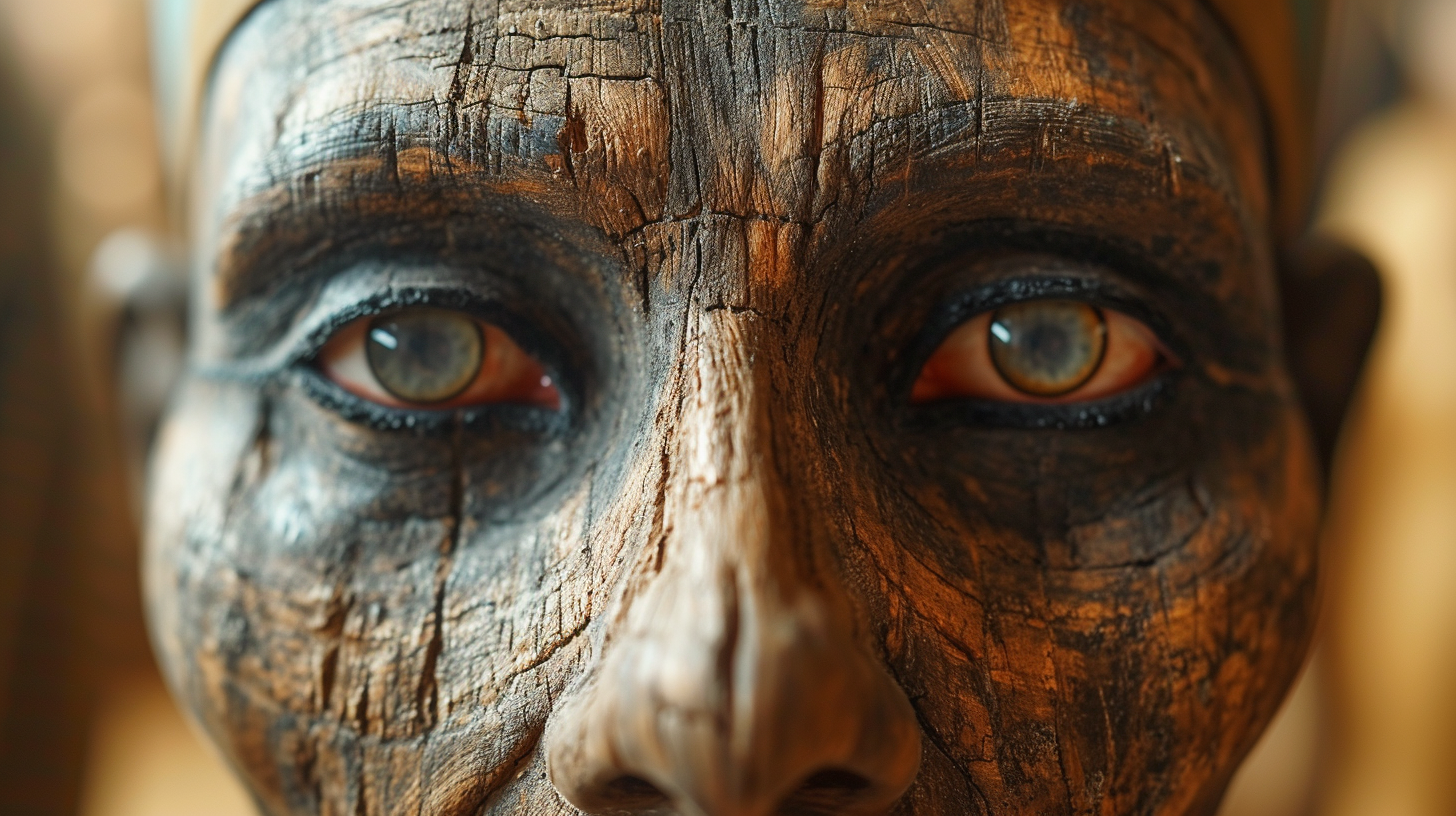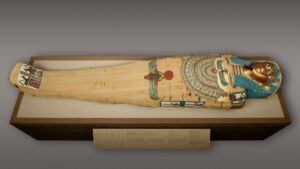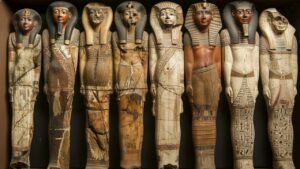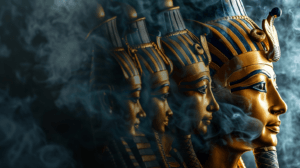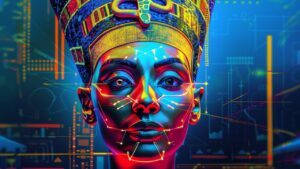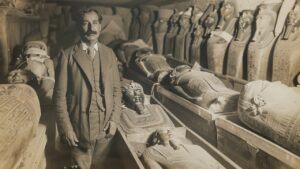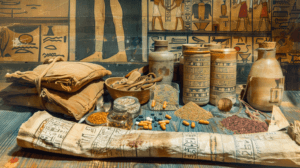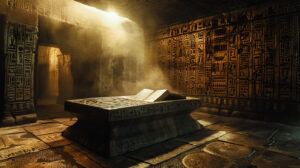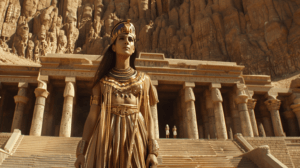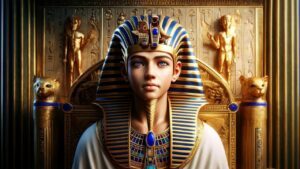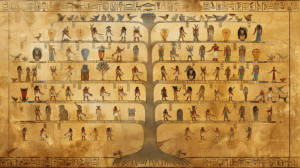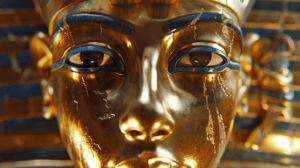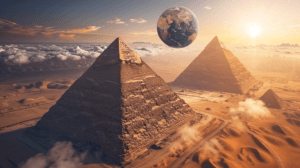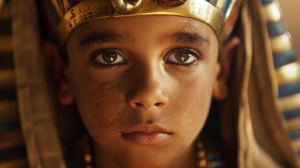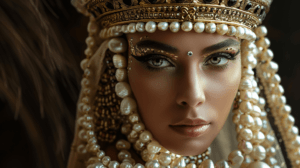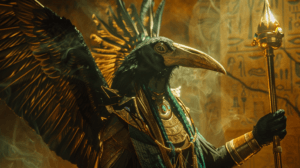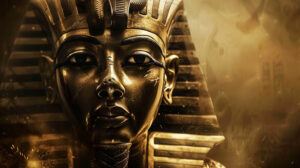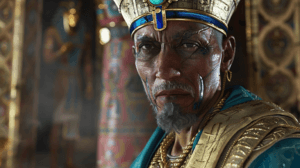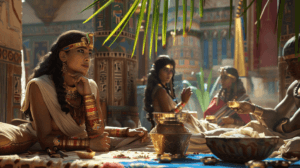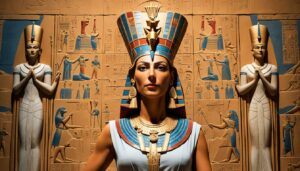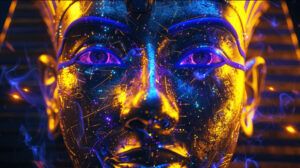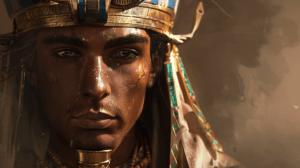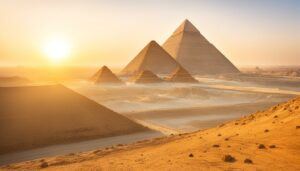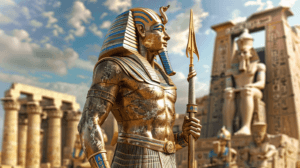What Are Egyptian Mummies?
Egyptian mummies are the preserved bodies of ancient Egyptians, carefully prepared through a complex process called mummification. These mummies are not just dried-out corpses; they are the result of an intricate religious and cultural practice aimed at ensuring eternal life for the deceased.
Mummies can be thousands of years old, yet they often retain recognizable features and provide invaluable insights into ancient Egyptian life, death, and beliefs about the afterlife. They range from elaborately preserved pharaohs to more modestly prepared commoners and even mummified animals.
The word “mummy” comes from the Arabic word “mummiya,” which means bitumen, a natural substance that the Arabs believed was used in the mummification process. However, the Egyptians called their mummified dead “sah,” meaning nobility or dignity.
Fun Fact: Some mummies are so well-preserved that we can see what people looked like 3,000 years ago!
What is Mummification?
Mummification is a remarkable process that ancient Egyptians developed to preserve their dead. This wasn’t just about keeping bodies from decaying; it was a crucial part of their beliefs about life after death. The Egyptians believed that preserving the body was essential for the deceased to have a successful afterlife.
They put a lot of effort into making sure the body stayed as life-like as possible, even thousands of years after death. The ancient Egyptian mummification process was complex and time-consuming, involving special tools, chemicals, and rituals. It wasn’t just about physical preservation; it also had deep religious significance.
Interestingly, some of the earliest mummies were created accidentally by the hot, dry sand of the Egyptian desert. The sand naturally preserved bodies buried in shallow graves. Over time, Egyptians developed increasingly sophisticated techniques to preserve their dead.
Fun Fact: Some Egyptian mummies are so well-preserved that we can see what people looked like 3,000 years ago!
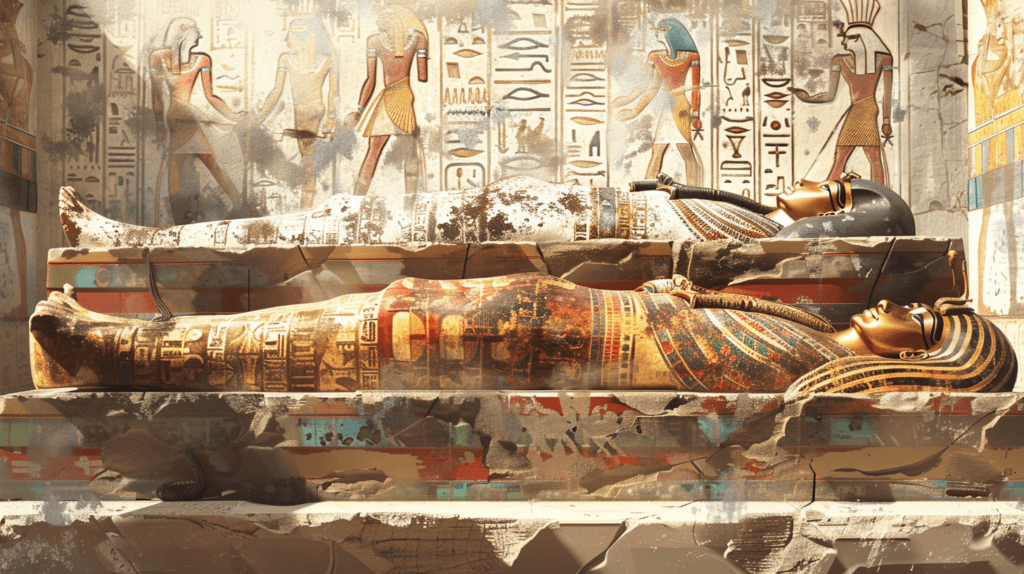
The History of Mummification
Mummification in Egypt has a long and fascinating history, spanning thousands of years. The practice evolved significantly over time, reaching its peak during the New Kingdom period. During this time, embalmers perfected their techniques, creating mummies that have lasted for millennia.
- Prehistoric times: Bodies were accidentally preserved by dry sand.
- Around 2600 BCE: Egyptians began intentional mummification.
- New Kingdom (1570–1075 BCE): The best quality mummies were produced.
- Roman Period (30 BCE–364 CE): Mummification continued until this time, gradually changing with the spread of Christianity.
The 7 Steps of Mummification
Mummification was a complex process that took about 70 days to complete. It was performed by skilled priests who were also embalmers. These priests had to be knowledgeable about human anatomy as well as the religious rituals associated with preparing a body for the afterlife. Here are the 7 steps of mummification:
Step 1: Washing
The body was washed with palm wine and rinsed with water from the Nile.
Step 2: Brain Removal
A hook was inserted through the nose to pull out brain tissue.
Step 3: Organ Removal
The lungs, stomach, liver, and intestines were removed through a cut in the side. The heart was left in place.
Step 4: Organ Preservation
The removed organs were preserved and placed in canopic jars.
Step 5: Drying
The body was covered and stuffed with natron salt and left for 40-50 days to dry out.
Step 6: Wrapping
The dried body was wrapped with long strips of linen. Amulets were placed between layers for protection.
Step 7: Funeral and Burial
The mummy was placed in a decorated coffin and tomb. Funeral rites were performed, including the “Opening of the Mouth” ceremony.
The Grand Funeral Ceremony
After the mummification process was complete, the ancient Egyptians held an elaborate funeral ceremony. This wasn’t just a time for mourning; it was a crucial step in helping the deceased transition to the afterlife.
The funeral was a grand affair, often lasting for days, especially for pharaohs and high-ranking officials. It involved a procession to the tomb, with mourners, priests, and often professional wailers. Sacred rituals were performed to ensure the deceased’s safe journey to the afterlife.
One of the most important parts of the ceremony was the “Opening of the Mouth” ritual. This ritual was believed to restore the mummy’s senses, allowing them to eat, speak, and use their senses in the afterlife. After all rituals were complete, the mummy was placed in its coffin, and the tomb was sealed.
Why Was Mummification So Important?
Mummification wasn’t just a burial practice; it was a fundamental part of ancient Egyptian religious beliefs. The Egyptians had a complex understanding of the afterlife and believed that preserving the body was crucial for the deceased’s eternal life.
They saw death not as an end, but as a transition to another form of existence. According to Egyptian beliefs, a person’s soul had multiple parts, and the preserved body played a vital role in keeping these parts united in the afterlife.
The Egyptians believed in three parts of the spirit:
- The ka: A “double” of the person that would remain in the tomb and needed offerings.
- The ba: Often translated as “soul,” it could leave the tomb and return.
- The akh: The transformed spirit that traveled to the afterlife.
Without a well-preserved body, the Egyptians believed these parts of the spirit might become lost or unable to unite in the afterlife.
Who Got the Mummy Treatment?
While we often associate mummification with pharaohs and their golden sarcophagi, the practice wasn’t limited to royalty. Over the long history of ancient Egypt, mummification was performed on people from various social classes. However, the quality and elaborateness of the mummification process often depended on the person’s status and wealth.
- Pharaohs and their families
- Nobles and important officials
- Some common people, though it was very expensive
- Certain animals with religious significance, like cats and crocodiles
Interestingly, it wasn’t just humans who were mummified. Animals played a significant role in Egyptian religion, and many were mummified as sacred offerings to the gods. Millions of mummified animals have been discovered, including cats, birds, and even crocodiles!
Mummies in Modern Times – What Can We Learn?
Mummies are more than just fascinating relics of the past; they’re invaluable sources of information about ancient Egyptian life, culture, and technology. Modern scientific techniques have revolutionized the way we study mummies, allowing us to learn more than ever before without damaging these precious artifacts.
From DNA analysis to advanced imaging techniques, scientists are continually developing new ways to unlock the secrets of the mummies. These studies provide insights not just into how people lived and died in ancient Egypt, but also into the development of diseases, the evolution of human genetics, and the sophistication of ancient medical practices.
- X-rays and CT scans let us see inside mummies without unwrapping them.
- We can learn about ancient Egyptian diseases and how they tried to treat them.
- By studying mummy bones, we can figure out how tall ancient Egyptians were and how long they usually lived.
- Mummies help us understand when different pharaohs ruled Egypt.

